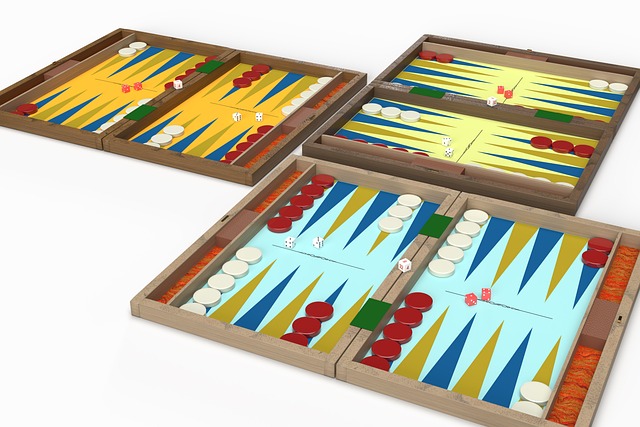How to play and how to do the Backgammon setup shall be the most important topics of this article. Dice and counters are used in the two-player board game backgammon, which is played on a table board. Of the several table games, whose ancestors can be traced back approximately 5,000 years to the regions of Mesopotamia and Persia, it is the most popular member in the Western world.
The game involves a combination of strategy and luck from rolling dice, where players move their pieces along twenty-four points on the board according to the roll of two dice. The objective is to move all of one’s pieces around the board and be the first to bear them off, i.e., remove them from the board.
How to play backgammon?
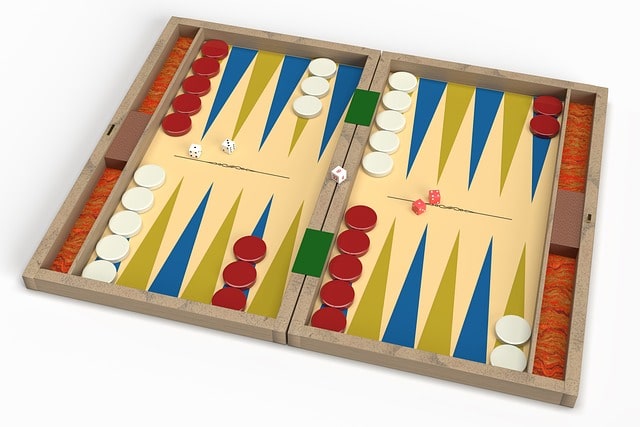
Dice and counters are used in the two-player board game backgammon, which is played on a table board. Here’s a detailed walk through on how to play and how to do the backgammon setup.
Setting Up
There are fifteen checkers of each player’s color. The initial arrangement of checkers is:
- 2 checkers on the 24 point.
- 5 checkers on the 13 point.
- 3 checkers on the 8 point.
- 5 checkers on the 6 point.
Board Layout:
The 24 long triangles on the board are referred to as points or pips. The points alternate in color and are divided into four quadrants of six triangles each. The quadrants are the player’s home board and outer board, and the opponent’s home board and outer board. The bar, a divider down the middle, divides the home boards from the outer boards.
Game play
Who Goes First:
Each player rolls a single die to determine who goes first. Using both of the rolled numbers, the player whose number is higher moves first. The dice are rolled again until both players roll separate numbers if they roll the same number.
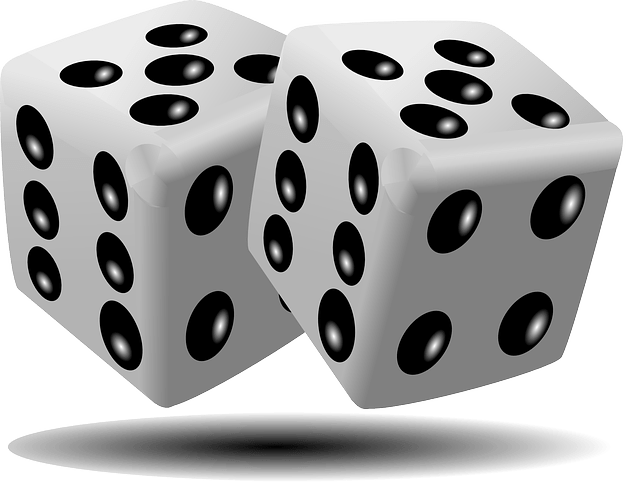
Rolling the Dice:
Players take alternating turns rolling two dice at the beginning of each turn. The dice must always be rolled together and land flat on the right-hand side of the game board. If it lands outside or on a checker, the dice must be rolled again.
Moving Checkers:
The number of points the player must move their checker depends on the outcome of the dice roll. The checker always advances toward the player’s home board by taking the horseshoe-shaped route. An open point is one that isn’t occupied by two or more opposing checkers. A checker can only land on an open spot when it is being moved.
Hitting and Entering:
If a checker is moved onto a point containing one opposing checker, the opposing checker is hit and removed from the board. The checker that hit the opposing checker can then move to the next point.
Bearing Off:
When a player has all their checkers in their home board, they can start removing them from the board, known as bearing off. This is done by rolling both dice and moving the corresponding number of points. The first player to bear off all their checkers wins the game.
Doubling and Gammons
Doubling Cube:
A doubling cube with the numbers 2, 4, 8, 16, 32, and 64 is used to keep track of the current stake of the game. The cube is turned over to indicate the owner of the cube, and the owner can propose to double the stakes at the start of any turn. The opponent can either accept the doubled stakes or resign and lose the match and the current stakes.
Gammons and Backgammons:
If a player bears off all their checkers and the opponent has borne off at least one checker, the player wins the current stake. If the opponent has not borne off any checkers, the player wins a gammon and loses double the current stakes. If the opponent has not borne off any checkers and still has one or more checkers on the bar, the player wins a backgammon and loses triple the current stakes.
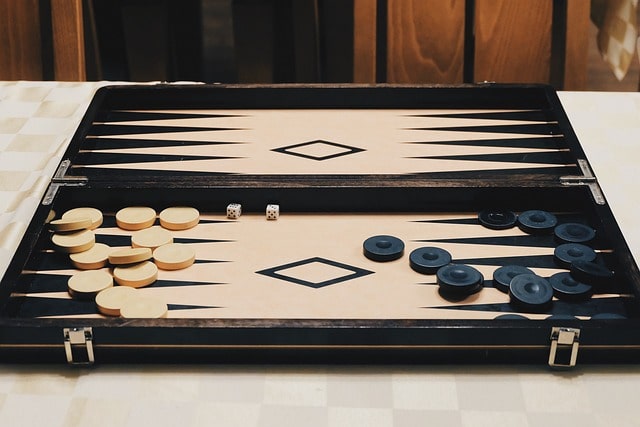
Tips and Strategies
Hit-and-Run:
If you hit an opposing checker, you are allowed to run your hitter to safety.
Passing:
If there is a method for you to legally play your part, you must. If you can’t play all of your numbers, you must play as many as you can.
Doubling:
You can double at the start of any turn, but be aware that your opponent may roll their dice without waiting to see what you do.
Conclusion
Backgammon is a game that combines strategy and luck, with the objective of moving all of one’s own checkers to the home board and then removing them from the board entirely. The game involves a combination of skill and chance, making it both challenging and engaging for players of all levels.
Strategies for playing backgammon
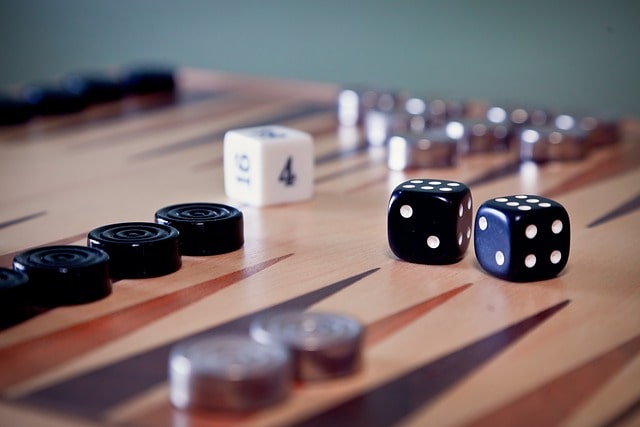
Running Game:
The Running Game involves moving your checkers towards your home board as quickly as possible. It is the simplest strategy and is effective if you have strong rolls early in the game. However, it is not a good strategy if your opponent has fewer pips remaining than you.
Blitz:
The Blitz is an aggressive strategy that involves hitting your opponent’s checkers whenever possible to send them to the bar. This can set your opponent back and potentially trap some checkers on the bar if they do not roll the right numbers to re-enter the board. However, it is crucial to avoid leaving open blots in your home board and to keep your opponent on the bar as much as possible.
Priming:
Priming involves creating a series of connected points on the board, known as a prime. This creates a wall that your opponent cannot pass without rolling a five or six. Priming works best in tandem with the Blitz, often known as the “two-way forward” offensive.
Anchoring:
Anchoring involves setting up a point to enter the board if your opponent is setting up a prime in their home board. This gives you a place to enter your checkers and prevents your home board from becoming completely full and your checkers from being stuck on the bar.
Back Game:
The Back Game is a strategy that involves controlling two or more points in your opponent’s inner table. The main objective is to hit a blot late in the game and contain it. It is a difficult strategy to play effectively, requiring a strong position and careful timing.
These strategies can be used individually or in combination, depending on the game situation and the player’s skill level.
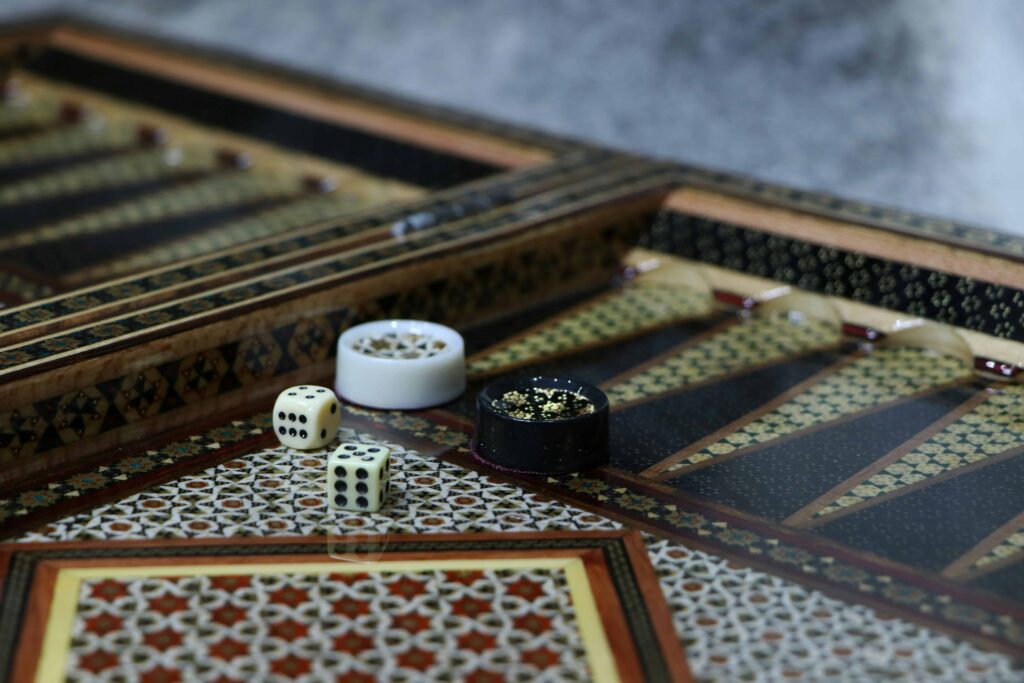
Rules to play backgammon
To play backgammon, follow these steps:
Setup:
There are fifteen checkers of each player’s color.
The initial arrangement of checkers is:
- 2 on each player’s 24 point.
- 5 on each player’s 13 point.
- 3 on each player’s 8 point.
- 5 on each player’s 6 point.
Rolling the Dice:
- Players take turns rolling two 6-sided dice.
- The roll indicates how many points, or pips, the player can move their checkers.
- If the dice show the same number, it is a double, and the player moves four times the number.
Moving Checkers:
- Every time, checkers are advanced to a point with a lower number.
- A player must use both numbers of a roll if possible (and all four numbers of a double).
The player must use a checker on a higher-numbered point to make a lawful move if there isn’t one on the point that the roll indicates.
Entering Checkers:
- If a player has one or more checkers on the bar, their first obligation is to enter those checkers into the opposing home board.
- To enter a checker, move it to an open location that matches a number on the dice that have been rolled.
Bearing Off:
- The goal is to move all of one’s checkers around the board and bear them off, i.e., remove them from the board.
- To bear off, a player must roll a number that corresponds to the point the checker is on.
- If there is no checker on the point indicated by the roll, the player must move a checker from the next highest occupied point instead.
Doubling:
- The doubling cube is used to keep track of the current stake of the game.
- A player can propose to double the stakes at the start of any turn.
- The opponent can either accept the double or resign and lose the match and the current stakes.
Gameplay Etiquette:
- The word “bar” stands for the checkers on the bar.
- The term “off” designates a checker that has been carried off.
- Players should agree on whether to play beavers (optional) and follow rules of etiquette for moves.
These rules provide the foundation for playing backgammon effectively.
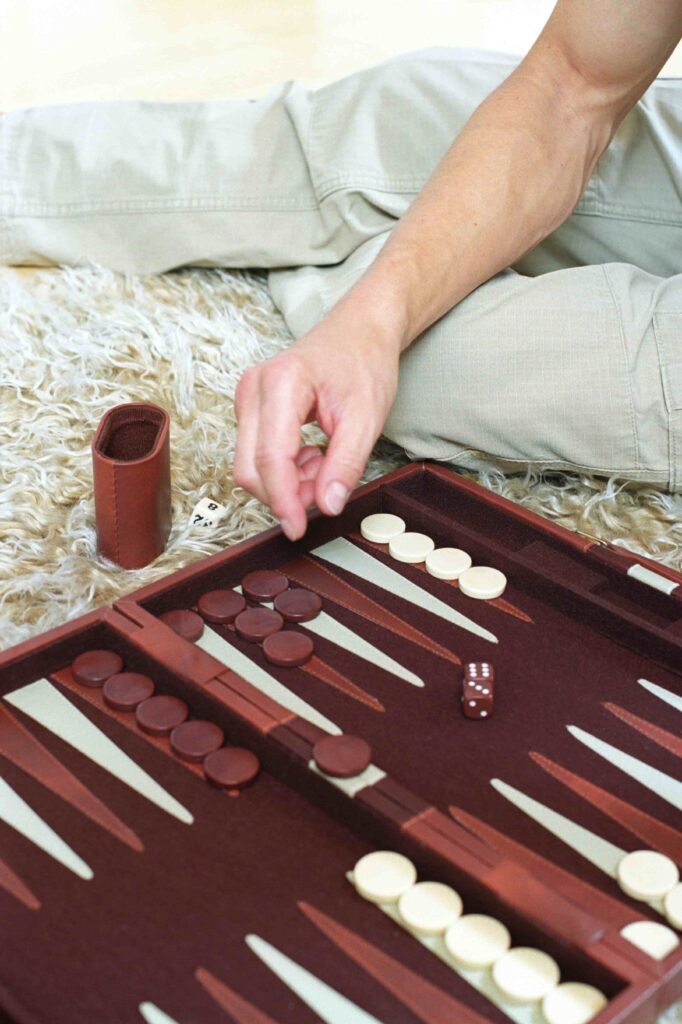
How to do backgammon setup board?
Here are the steps to set up a backgammon board:
- Place the backgammon board on a flat surface between the two players.
- Each player takes 15 checkers of their own color.
- Arrange the checkers on the board as follows:
- Place 5 of your checkers on your 6-point
- Place 3 of your checkers on your 8-point
- Place 5 of your checkers on your 13-point
- Place 2 of your checkers on your 24-point
- Your opponent should mirror your setup, placing their checkers on the corresponding points on their side of the board.
- Make sure no checkers overlap and that each player’s checkers are clearly separated on the board.
- Decide who will go first. This is typically determined by each player rolling a single die, with the higher roller taking the first turn.
- If the game will use a doubling cube, place it off to the side of the board, set to the starting value of 1.
That’s it! The backgammon board is now set up and ready for gameplay. The players can then take turns rolling the dice and moving their checkers around the board according to the game rules.
What is bearing off in backgammon?
The action of taking checkers off the backgammon board is called bearing off. It is the final stage of the game where a player aims to be the first to bear off all of their checkers. Here are the key points about bearing off:
Initial Conditions:
To bear off, all of a player’s checkers must be in their home board. The action of taking checkers off the backgammon board is called bearing off.
Rolling the Dice:
The player rolls the dice to determine how many points they can move their checkers. They can bear off a checker by rolling a number that corresponds to the point on which that checker resides.
Legal Moves:
If there is no checker on the point indicated by the roll, the player must make a legal move using a checker on a higher-numbered point. If there are no checkers on higher-numbered points, the player must remove a checker from the highest point occupied by one of their pieces
Hit Checkers:
If one of a player’s checkers is hit while they are bearing off, they must re-enter the checker and move it back to the home board before they can resume bearing off.
Winning Conditions:
The game is won when a player bears off all of their checkers before their opponent. If the opponent bears off at least one checker, the win is considered a single game. If the opponent fails to bear off any checkers and still has checkers on the bar or in the home board, the win is considered a gammon.
Strategic Considerations:
Bearing off is a strategic part of the game. Players must carefully manage their checkers to ensure they can bear off efficiently. This includes considering the potential for doubles and the impact of bad rolls on their chances of winning.
In summary, bearing off is the final stage of backgammon where players aim to remove all their checkers from the board. It involves rolling the dice to determine how many points to move, making legal moves, and managing checkers to ensure efficient removal.
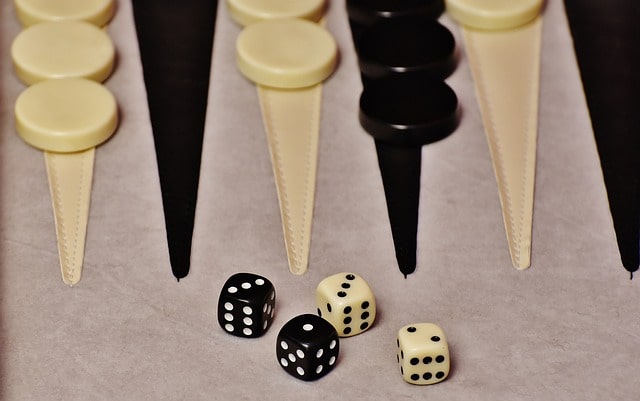
Rules for bearing off in backgammon
Here are the key rules for bearing off in backgammon:
- You can only start bearing off once you have moved all 15 of your checkers into your home board.
- To bear off a checker, you must roll a number that corresponds to the point the checker is on. For example, if you roll a 5, you can bear off a checker from the 5-point.
- If there is no checker on the point indicated by your roll, you must move a checker from the next highest occupied point instead. The excess pips are lost.
- You are not required to bear off if you can make a legal move instead. However, you must use all the numbers rolled if possible.
- You cannot restart bearing off if one of your checkers gets hit while you are bearing off; instead, you must re-enter that checker on the bar and move it back into your home board.
- The first player to bear off all 15 of their checkers wins the game. If your opponent has borne off at least one checker, it’s a single game win. If they haven’t borne off any, it’s a gammon. If they still have checkers on the bar or in your home board, its backgammon.
In summary, the key is to get all your checkers into your home board as quickly as possible, and then systematically bear them off using the dice rolls, while preventing your opponent from hitting your checkers and disrupting your bearing off process.
What is doubling cube in backgammon.
The doubling cube is a crucial element in backgammon that allows players to raise the stakes during the game. It is a marker with the numbers 2, 4, 8, 16, 32, and 64 inscribed on its sides to denote the current stake. Here are the key points about the doubling cube:
Initial Value:
The doubling cube starts with a value of 1 point, which is the initial stake for each game.
Doubling:
When a player feels they have the advantage, they can offer to double the stakes before rolling the dice. This means the game is now worth twice the initial stake.
Acceptance or Decline:
The opponent can either accept the double, in which case the game continues at the doubled stakes, or decline, which means they concede the game and lose the current stake.
Ownership:
When a player accepts a double, they take control of the doubling cube and can decide whether to redouble or not.
Redoubling:
A player who is doubled can immediately redouble the stakes, effectively doubling the current stake again. This can be done multiple times, with no limit on the number of redoubles.
Gammon and Backgammon:
The doubling cube affects the value of gammons and backgammons. A gammon is worth twice the current stake, and a backgammon is worth three times the current stake.
Strategic Importance:
The doubling cube adds a significant strategic layer to the game, as players must carefully consider when to double and when to accept a double. It is a key element in determining the outcome of the game.
History:
The doubling cube was introduced in the mid-1920s and is credited with adding longevity to the game of backgammon.
In summary, the doubling cube is a crucial element in backgammon that allows players to raise the stakes during the game. It is a marker with the numbers 2, 4, 8, 16, 32, and 64 inscribed on its sides to denote the current stake.
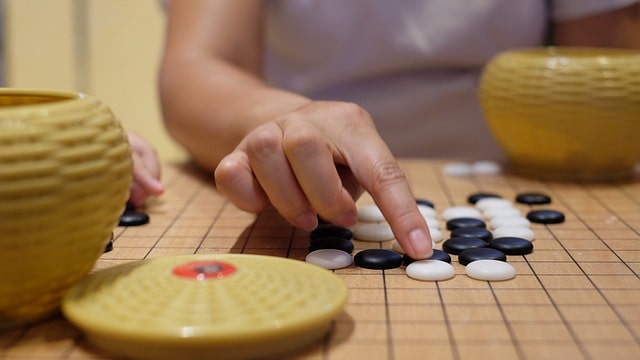
How does the doubling cube affect the game strategy?
The doubling cube significantly affects the game strategy in backgammon by introducing an element of risk and reward. Here are some key ways it impacts the game:
Risk and Reward:
The doubling cube allows players to increase the stakes of the game by proposing to double the current stakes. This adds a strategic layer to the game, as players must weigh the potential gains against the risk of losing more points if their opponent accepts the double.
Cube Ownership:
The player who accepts a double becomes the owner of the cube and has the right to propose further doubles. This gives them an advantage in terms of being able to increase the stakes and potentially gain more points if they win the game.
Doubling Strategy:
Players must consider the doubling cube when making decisions about whether to double or accept a double. The general rule is that a player should double when they have a 25% or higher chance of winning the game, and their opponent should take the double when they have a 25% or higher chance of winning.
Market Losers:
The concept of market losers is important in doubling cube strategy. A market loser is a sequence of rolls that would cause a player’s position to deteriorate. Players should avoid doubling when they have market losers, as it can lead to significant losses if their opponent takes the double.
Gammon and Backgammon:
The doubling cube affects the value of gammons and backgammons. A gammon is worth twice the current stakes, and a backgammon is worth three times the current stakes. This means that players must carefully consider the potential gains and losses when deciding whether to double or accept a double.
Cube Timing:
Players must carefully time their doubles to maximize their gains. Doubling too early can lead to giving away the cube and losing potential points, while doubling too late can mean missing opportunities to increase the stakes.
Away Points:
Players should focus on the away points, which are the points needed to win the match. This helps them make more informed decisions about doubling and accepting doubles, as they can better assess the potential gains and losses.
Doubling Window:
The doubling window is the range of winning chances where both the double and the take are correct. This is typically around 70% to 78%. Players should aim to double within this window to maximize their gains.
Cube Management:
Players must manage the cube effectively by considering the potential gains and losses of each double. They should avoid giving away the cube too readily and aim to keep it for as long as possible to maximize their gains.
Gameplay Adaptation:
The doubling cube requires players to adapt their gameplay strategy. They must be prepared to adjust their checker play and doubling strategy based on the current score and the potential gains and losses.
Overall, the doubling cube adds a complex layer of strategy to backgammon, requiring players to carefully consider the risks and rewards of each double and adjust their gameplay accordingly.
Advanced techniques for using the doubling cube effectively.
There are several advanced techniques for using the doubling cube effectively in backgammon:
Knowing When to Double
- Double when you have a solid lead, even if you’re not sure you can win the game. This puts pressure on your opponent and can lead to them dropping the double.
- Consider putting yourself in your opponent’s shoes – if they doubled you, would you take? If not, you should probably double.
- A general rule of thumb is to double if you are ahead by 10% in pip count. You can take with up to a 12-13% deficit in pip count.
Knowing When to Take
- Take a double if you have a 25% or higher chance of winning the game. If you drop, you lose the current stakes. If you take and win, you break even compared to dropping.
- Consider the range of your winning chances on the next roll. If it’s a wide range, it may be better to take and see what happens rather than drop.
Cube Ownership
- Owning the cube gives you the power to double again and increase the stakes. Try to keep control of the cube if you can.
- Beavering allows you to immediately double down if your opponent takes your double. This retains cube ownership.
Adapting to Your Opponent’s Skill Level
- If your opponent is less experienced, be conservative with the cube. If you get far ahead, offer a double but stay focused.
- If you are less experienced, be wary of doubling too quickly. Focus on playing the checkers well before worrying about the cube.
Other Considerations
- Pay attention to your board structure and how smoothly you can bear off. Gaps in your board can waste crucial die rolls.
- Remember that every roll is a new cube decision. Don’t assume you can’t double just because it’s late in the game.
In summary, effective use of the doubling cube requires carefully assessing your position, your opponent’s likely response, and the potential impact on the game’s stakes. With practice, you can master the art of cube management to gain an edge in backgammon.
Contact Us for any Question related to this Article.
FAQs Frequently Asked Questions
What is the objective of backgammon?
The objective of backgammon is to move all of your checkers around the points and into your home board and then bear them off. The winner is the first player to remove every checker from the board.
When it’s my turn to roll, can I pass?
No, you have to roll when it’s your turn and take all appropriate legal action. The only exception is if your opponent’s home board is closed and you have a checker on the bar (see below). Since there is no way to reenter from the bar in this case, you forfeit your turn.
What is the bar?
The bar is the raised ridge running down the center of the board that divides the inner table from the outer table. After your checkers are hit, you place them on the bar.
What are the inner and outer tables?
The home board is another name for the inner board. Backgammon boards usually fold in half. The terms “inner table” and “outer table” refer to the two parts of the board. The way the checkers are arranged determines which side the inner table is on. The inner table is to your right if you bear your checkers off to the right. The inner table is to your left if you veer off to the left.
How do I move my checkers?
Checkers are always moved forward, to a lower-numbered point. A player must use both numbers of a roll if possible (or all four numbers of a double). The player must use a checker on a higher-numbered point to make a lawful move if there isn’t one on the point shown by the roll.
What is a double?
A double would result from rolling the same number on both dice, such as 4-4. In the event that you rolled a double, you would shift the number four times rather than twice.
How do I bear off?
Once all pieces are present in a player’s inner table, that player can start “bearing off”. A throw of 1 allows a player to bear off a piece from point 1 of his home board
What is the best strategy in backgammon?
There is no single best strategy in backgammon. The game is a mixture of strategy and luck, so the game’s circumstances are constantly changing. As a result, as the game progresses, the necessary approach may also vary. Generally, there are five strategies available: the blitz, the back game, the holding game, the priming game, and the running game
How do I decide which strategy to use?
Knowing which strategy to use in a certain situation is a crucial backgammon ability. This requires understanding the game’s circumstances and adapting to them
What equipment do I need to play backgammon?
You need a backgammon board, thirty checkers of two different colors (15 of each color), two pairs of dice, and an opponent
What is the official size for a tournament backgammon board?
Official standards for size do not exist. The majority of events don’t have board size regulations. Nonetheless, competition boards are usually designed to accommodate a checker with a diameter of about 44 mm.
What is the price range for a good backgammon set?
There are high-quality backgammon sets for any budget, ranging from £20 to hundreds of pounds. Please review the price-based recommendations on our website.
What do I have to consider about the dice?
Generic plastic or wooden dice are suitable for group play. Always try to use precise dice for serious play. These are made specifically to guarantee random, consistent rolls.
